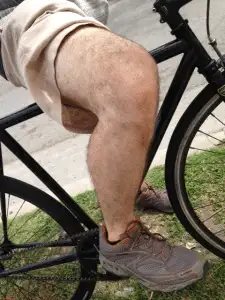By Qineng Tan, L.Ac. Ph.D.
Osteoarthritis of the knee is one of the most common complaints causing people pain and loss of total mobility worldwide. Pain, stiffness of the joint, limited function, and sometimes a “clicking” or other sound, are symptomatic of this condition, which tends to worsen with age. Degeneration of the cartilage that cushions the knee joint, along with injury or degeneration of the ligaments, tendons, muscles and surrounding tissues that support the functioning of the knee, all play a role in the development of osteoarthritis of the knee.
The treatment typically offered is the prescription of anti-inflammatory drugs, which may provide some temporary relief but does not really heal the condition. Fortunately, Traditional Chinese Medicine can treat osteoarthritis, and several scientific studies conducted in recent years have demonstrated that acupuncture offers significant relief for this condition.
From a Chinese Medicine perspective, we do not view this problem as being isolated in the knee. We pay close attention to any blockage in the lower extremities because the legs are like a “second heart” for the body. We rely on the large muscles of the legs to push the blood upwards, completing the “circle” of circulation. So if there is a problem in the leg, it not only affects the knees, but all of the organs.
a “second heart” for the body. We rely on the large muscles of the legs to push the blood upwards, completing the “circle” of circulation. So if there is a problem in the leg, it not only affects the knees, but all of the organs.
In TCM, arthritis is called “Bi Syndrome.” Bi syndrome refers to conditions that create pain, stiffness, soreness, or numbness in the muscles, tendons and joints. There are various differentiations of Bi Syndrome, each referring to a type of bodily invasion by external climate factors: Wind, Dampness, Heat, and Cold. A TCM practitioner makes a determination about what type of Bi Syndrome is being presented based on the patient’s description of their pain and other symptoms, as well as by studying the appearance of the tongue and feeling the pulse. For example, if a person describes knee pain that improves when warmth is applied, and worsens when the area is exposed to cold, and we observe a thin, white coating on the tongue, along with a wiry, tight pulse, we will diagnose this as a “Cold Pattern Bi.” A “Damp Pattern Bi” is characterized by pain and swelling in the joint, and a feeling of heaviness and numbness in the limbs, a sticky tongue coating, and a slow, “soggy” pulse.
The point is, while many people suffer “knee pain,” not every case is the same, and the same treatment will not work for everyone. A TCM provider will zero in on the specific situation surrounding your knee pain, and treat it accordingly with acupuncture treatment, herbal formulae, and a dietary plan that will address the type of inflammation you are experiencing.
One recent study treated 32 patients who were waiting to have knee replacement surgery. The patients who received acupuncture treatment during the nine weeks of the study reported decreased pain, and the ability to walk farther and faster, while those who did not receive acupuncture reported continued increase in their pain.
How exactly does acupuncture help? From a scientific point of view, it increases the production of endorphins and the anti-inflammatory hormone adrenalcorticotropin. A treatment plan may include electro-acupuncture, moxa, cupping, herbs, dietary recommendations and lifestyle changes. Herbal formulas that address Bi Syndrome patterns have been in use for hundreds of years in TCM. They can help resolve dampness and cold and bring more warmth and circulation to the knee joint. A proper diet can go several steps further in treating inflammation, and preventing it from recurring.
If you or someone you love is experiencing chronic joint pain and loss of motion, there is hope for relief. Give Traditional Chinese Medicine a try.
